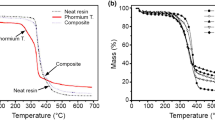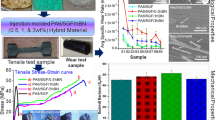Abstract
Silica nanoparticles (SN) and epoxidized natural rubber (ENR) were used as binary component fillers in toughening diglycidyl ether of bisphenol A (DGEBA) cured cycloaliphatic polyamine. For a single component filler system, the addition of ENR resulted in significantly improved fracture toughness (KIC) but reduction of glass transition temperature (Tg) and modulus of epoxy resins. On the other hand, the addition of SN resulted in a modest increase in toughness and Tg but significant improvement in modulus. Combining and balancing both fillers in hybrid ENR/SN/epoxy systems exhibited improvements in the Young’s modulus and Tg, and most importantly the KIC, which can be explained by synergistic impact from the inherent characteristics associated with each filler. The highest KIC was achieved with addition of small amounts of SN (5 wt.%) to the epoxy containing 5–7.5 wt.% ENR, where the KIC was distinctly higher than with the epoxy containing ENR alone at the same total filler content. Evidence through scanning electron microscopy (SEM) and transmission optical microscopy (TOM) revealed that cavitation of rubber particles with matrix shear yielding and particle debonding with subsequent void growth of silica nanoparticles were the main toughening mechanisms for the toughness improvements for epoxy. The fracture toughness enhancement for hybrid nanocomposites involved an increase in damage zone size in epoxy matrix due to the presence of ENR and SN, which led to dissipating more energy near the crack-tip region.










Similar content being viewed by others
References
May C (1988) Epoxy resins chemistry and technology. Marcel Dekker Inc, New York
Ruamcharoen P, Umaree S, Ruamcharoen J (2011) Relationship between tensile properties and morphology of epoxy resin modified by epoxidised natural rubber. Mater Sci Eng 5:504–510
Liu H-Y, Wang G-T, Mai Y-W, Zeng Y (2011) On fracture toughness of nano-particle modified epoxy. Compos Part B- Eng 42:2170–2175
Akinyede O, Mohan R, Kelkar A, Sankar J (2009) Static and fatigue behavior of epoxy/fiberglass composites hybridized with alumina nanoparticles. J Compos Mater 43:769–781
Liang YL, Pearson RA (2010) The toughening mechanism in hybrid epoxy-silica-rubber nanocomposites (HESRNs). Polymer 51:4880–4890
Dittanet P, Pearson RA (2012) Effect of silica nanoparticle size on toughening mechanisms of filled epoxy. Polymer 53:1890–1905
Bagheri R, Pearson RA (1996) Role of particle cavitation in rubber-toughened epoxies:1. Microvoid toughening. Polymer 20:4529
Dittanet P, Pearson RA (2013) Effect of bimodal particle size distributions on the toughening mechanisms in silica nanoparticle filled epoxy resin. Polymer 54:1832–1845
Vijayan PP, Piontech J, Huczko A, Puglia D, Jenny JM, Thomas S (2014) Liquid rubber and silicon carbide nanofiber modified epoxy nanocomposites: volume shrinkage, cure kinetics and properties. Compos Sci Technol 102:65–73
Tan SK, Ahmad S, Chia CH, Mamum A, Heim HP (2013) A comparison study of liquid natural rubber (LNR) and liquid epoxidized natural rubber (LENR) as the toughening agent for epoxy. Am J Mater Sci 3:55–61
Johnsen BB, Kinloch AJ, Mohammed RD, Taylor AC, Sprenger S (2007) Toughening mechanisms of nanoparticle-modified epoxy polymers. Polymer 48:530–541
Quan D, Ivankovic A (2015) Effect of core–shell rubber (CSR) nano-particles on mechanical properties and fracture toughness of an epoxy polymer. Polymer 66:16–28
Yahyaie H, Ebrahimi M, Tahami HV, Mafi ER (2013) Toughening mechanisms of rubber modified thin film epoxy resins. Prog Org Coat 76:286–292
Sharma RA, Melo DD, Bhattacharya S, Chaudhari L, Swain S (2012) Effect of nano/micro silica on electrical property of unsaturated polyester resin composites. Trans Electr Electron Mater 13:31–34
Blees MH, Winkelman GB, Balkenende AR, den Toonder JMJ (2000) The effect of friction on scratch adhesion testing: application to a sol-gel coating on polypropylene. Thin Solid Films 359:1–13
El-Sayed S, Abel-Baset T, Elfadl AA, Hassen A (2015) Effect of nanosilica on optical, electric modulus and AC conductivity of polyvinyl alcohol/polyaniline films. Phys B Condens Matter 464:17–27
Liang YL, Pearson RA (2009) Toughening mechanisms in epoxy–silica nanocomposites (ESNs). Polymer 50:4895–4905
Zhang H, Tang L-C, Zhang Z, Friedrich K, Sprenger S (2008) Fracture behaviours of in situ silica nanoparticle-filled epoxy at different temperatures. Polymer 49:3816–3825
Zhang H, Zhang Z, Friedrich K, Eger C (2006) Property improvements of in situ epoxy nanocomposites with reduced interparticle distance at high nanosilica content. Acta Mater 54:1833–1842
Lauke B (2008) On the effect of particle size on fracture toughness of polymer composites. Compos Sci Technol 68:3365–3372
Hsieh CL, Tuan WH (2007) Thermal expansion behavior of a model ceramic–metal composite. Mater Sci Eng A 460:453–458
Johnsen BB, Kinloch AJ, Taylor AC (2005) Toughness of syndiotactic polystyrene/epoxy polymer blends: microstructure and toughening mechanisms. Polymer 46:7352–7369
Ismail H, Shaari SM, Othman N (2011) The effect of chitosan loading on the curing characteristics, mechanical and morphological properties of chitosan-filled natural rubber (NR), epoxidised natural rubber (ENR) and styrene-butadiene rubber (SBR) compounds. Polym Test 30:784–790
Noriman NZ, Ismail H, Rashid AA (2010) Characterization of styrene butadiene rubber/recycled acrylonitrile-butadiene rubber (SBR/NBRr) blends: the effects of epoxidized natural rubber (ENR-50) as a compatibilizer. Polym Test 29:200–208
Chikhi N, Fellahi S, Bakar M (2002) Modification of epoxy resin using reactive liquid (ATBN) rubber. Eur Polym J 38:251–264
Xu SA, Wang DGT, Mai YW (2013) Effect of hybridization of liquid rubber and nanosilica particles on the morphology, mechanical properties, and fracture toughness of epoxy composites. J Mater Sci 48:3546–3556
Sprenger S, Kothmann MH, Altstaedt V (2014) Carbon fiber-reinforced composites using an epoxy resin matrix modified with reactive liquid rubber and silica nanoparticles. Compos Sci Technol 105:86–95
Hertzberg RW, Vinci RP, Hertzberg JL (2012) Deformation and fracture mechanics of engineering materials. Wiley, New York
Kinloch AJ, Mohammed RD, Taylor AC (2005) The effect of silica nano-particles and rubber particles on the toughness of multiphase thermosetting epoxy polymers. Mater Sci 40:5083–5086
Roberts AD (1990) Natural rubber science and technology. Oxford, UK
Bacigalupo LN (2013) Fracture behavior of nano-scale rubber-modified epoxies. Dissertation, Lehigh University, USA
Huang Y, Kinloch AJ (1992) Modelling of the toughening mechanisms in rubber-modified epoxy polymers. J Mater Sci 27:2753–2762
Azimi HR, Pearson RA, Hertzberg RW (1992) Fatigue of hybrid epoxy composites: epoxies containing rubber and hollow glass spheres. Polym Eng Sci 36:2352–2365
Bray DJ, Dittanet P, Guild FJ, Kinloch AJ, Masania K, Pearson RA, Taylor AC (2013) The modelling of the toughening of epoxy polymers via silica nanoparticles: the effects of volume fraction and particle size. Polymer 54:7022–7032
Sprenger S (2013) Epoxy resins modified with elastomers and surface-modified silica nanoparticles. Polymer 54:4790–4797
Sun Y, Zhang Z, Wong CP (2005) Study on mono-dispersed nano-size silica by surface modification for underfill applications. J Colloid Interface Sci 292:436–444
Acknowledgements
This research is supported in part by the Graduate Program Scholarship from the Graduate School, Kasetsart University, the Thailand Research Fund (TRF) through Grant No. TRG5780252, the Kasetsart University Research and Development Institute (KURDI), and the Faculty of Engineering at Kasetsart University. Epoxy resins and Nanopox® were kindly supplied by Aditya Birla Chemicals Thailand (Epoxy division) and Evonik Industries, respectively.
Author information
Authors and Affiliations
Corresponding author
Rights and permissions
About this article
Cite this article
Leelachai, K., Kongkachuichay, P. & Dittanet, P. Toughening of epoxy hybrid nanocomposites modified with silica nanoparticles and epoxidized natural rubber. J Polym Res 24, 41 (2017). https://doi.org/10.1007/s10965-017-1202-y
Received:
Accepted:
Published:
DOI: https://doi.org/10.1007/s10965-017-1202-y




